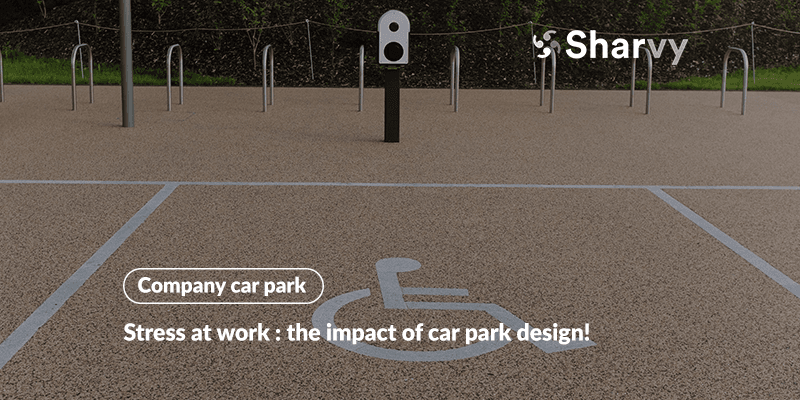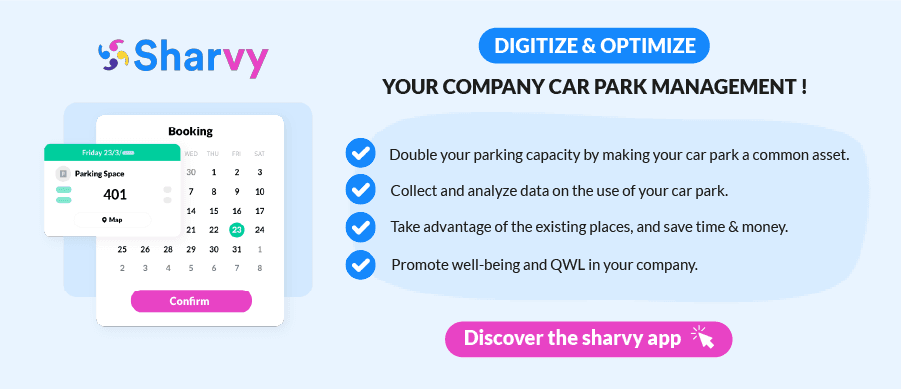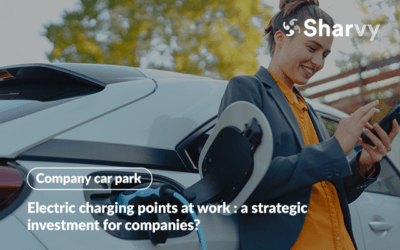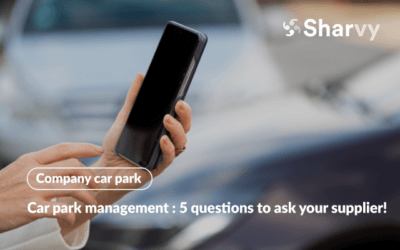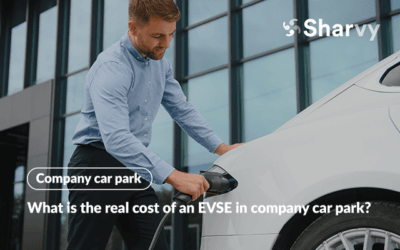Every morning, millions of people start their working day in their car, stuck in traffic jams, looking for a parking space: but they can’t find one. This moment, often seemingly trivial, is in reality a real source of stress.
Today, more than ¼ of employees in UK believe that their daily commute has a negative impact on their morale, with the search for a parking space being one of the main factors! This loss of time generates frustration and stress, especially as 72% of employees are already affected by long journeys.
Even so, the layout of company car parks is still too often seen as a mere logistical detail. However, if it is well designed, it can become a real lever for Quality of Life at Work (QWL), reducing daily anxiety and promoting a calm arrival at the workplace.
So how can a car park be transformed into a well-being asset for employees? What simple and innovative features can make all the difference? Focus in this article.
The link between parking and stress in the workplace.
Although we often talk about the causes of stress at work, parking is rarely at the top of the list. Yet for many employees, the daily quest for a parking space is becoming a real source of tension.
Driving for long minutes around the company premises, arriving late because there is no parking space available, having to park far away, sometimes in unsafe areas. These seemingly trivial situations generate a form of insidious stress, often downplayed, but very real!
But this morning stress is not trivial: it sets the tone for the day. A hurried and frustrated arrival can have an impact on concentration, mood and mental availability. Over time, this (daily) inconvenience contributes to a form of latent exhaustion and alters the perception of the working environment.
But it’s not just the lack of space that’s the problem. It also lies in the lack of organisation and clarity: a poorly thought-out car park, with no appropriate signage and no fair rules, creates frustration, confusion and sometimes even tension between colleagues.
When parking is neglected, it can become a source of chronic stress.
Car park design: a lever for well-being in the workplace?
1. Accessibility and clear signage.
The parking experience begins as soon as you arrive on site. An easily accessible car park, with clear & visible signage, immediately limits sources of confusion and tension.
Think of the car park from the user’s point of view, with: clearly identified entrances, a hierarchy of zones, and clear signs to help employees and visitors find their way around quickly and effortlessly.
However, it’s important to remember that signage must be adapted to the actual flow of traffic and the configuration of your site. Too many car parks have signage that is either inadequate or overloaded with information, which paradoxically makes it harder to read and generates more hesitation.
Good signage isn’t something you can see: it’s something you can understand immediately.
2. Safe pedestrian routes from car parks to buildings.
Once you’ve parked, the route to the premises must also be smooth and safe. Well-marked pedestrian crossings, separated from traffic lanes, lit and, if possible, covered, reassure users.
This may seem obvious, but in many car parks these facilities are non-existent, discontinuous or poorly maintained. As a result, pedestrians have to weave between vehicles, sometimes in the dark, which is neither safe nor welcoming.
This lack of attention often reflects an implicit hierarchy of priorities, where car traffic takes precedence over personal safety. It’s not just a question of avoiding accidents, but of creating an environment that inspires confidence and respect right from the first step.
3. Presence sensors & real-time display panels.
By indicating (in real time) when a space is free, these devices help to smooth traffic flow on the site & avoid the stress of endless rounds. For employees, it’s an immediate relief: they know where to go, without having to guess and hope.
However, these technologies have their limits. First of all, they do not in themselves guarantee a fair distribution of seats. If overall capacity is insufficient, the system will only signal a shortage, without offering any real solution. Secondly, the sensors can sometimes detect anomalies (for example, a space occupied by an incorrectly parked vehicle, such as a two-wheeler), distorting the information transmitted in real time.
Finally, this type of device requires regular maintenance and precise calibration to remain reliable. Without this, employees run the risk of being confronted with a space that is advertised as free, but which is already occupied. The user experience can therefore quickly deteriorate if the technology is not properly integrated into an overall approach to parking management.
These constraints make the usefulness of these sensors all the more apparent in very large companies, where the high number of vehicles makes precise & dynamic management of available spaces essential, thereby effectively reducing parking-related stress.
4. Reserved areas for certain groups (PRM, carpooling, two-wheelers).
Inclusion also involves parking. Providing suitable spaces for people with reduced mobility, spaces for shared vehicles and dedicated spaces for two-wheelers means recognising the diversity of uses and needs.
However, without an effective reservation and management system, these spaces can quickly become a source of frustration. Without control and clear allocation, there is a risk that these spaces will be occupied by unauthorised vehicles, which undermines the objective of fairness and accessibility.
This is where reservation comes into its own. By enabling the beneficiaries of these spaces to reserve them in advance via a Parking Management solution (such as Sharvy), we ensure not only that they are actually available, but also that the overall parking situation is better organised. Reserving reduces conflicts of use & guarantees fluid access to these priority zones.
5. Charging stations dedicated to electric vehicles.
With the growth in electric mobility, recharging points are becoming essential, and a strong marker of ecological commitment.
However, these facilities have certain limitations. There are often not enough of them to meet the growing demand, which can lead to conflicts of use and frustration when the charging points are occupied, or monopolised all day by the same vehicle.
What’s more, without an effective management system, it’s difficult to control charging times, avoid overcharging and guarantee fair access for all users.
This is precisely where Sharvy comes in, by optimising the charging points management. Thanks to its platform, users can book their charging slot in advance, avoiding unnecessary waiting times and conflicts. Sharvy also provides real-time monitoring of charging point occupancy, enabling smoother rotation and optimised use of available resources. In addition, the solution can send alerts when recharging is complete, encouraging users to vacate the charging point quickly.
In this way, the Sharvy application transforms the charging points into a truly intelligent service, guaranteeing comfort, fairness and efficiency in the use of electrical infrastructure.
6. Security cameras & automatic access control.
A secure car park is a guarantee of peace of mind. Installing surveillance cameras and automated access control (number plate recognition, etc.) reassures users, limits intrusions and prevents incivilities.
As a result, the ANPR system is regularly chosen by companies. What’s more, it is all the more effective if it is linked to the Sharvy application. In practical terms, when an employee books a parking space via Sharvy, his or her number plate is recorded for the chosen slot.
On the day, when they enter the car park, the camera identifies the number plate & automatically triggers the barrier to open, without human intervention or the need to present a badge.
This makes access much smoother, especially at peak times, while reducing errors and abuse, since only people with an active reservation can enter.
The system also avoids conflicts of use: spaces are allocated in advance, which guarantees that an authorised user will find a free space when they arrive. Combined with number plate recognition, this reservation logic enhances both security and the user experience, while giving the company clear traceability of entrances and exits, without overburdening day-to-day management.
7. An inflation station with minor maintenance for bikes and scooters.
Encouraging soft mobility also means offering the right services. A self-service filling station, a tool kit for small repairs and a sheltered area for bicycles show that the company is taking changing usage seriously.
These small, practical and useful gestures reinforce the motivation to adopt alternative modes of transport, without logistical stress.
8. Green spaces around the car park for a more calming environment.
Finally, the visual environment plays a significant role in well-being. Landscaping the area around the car park with plants, hedges and a few trees helps to break away from the coldness often associated with parking areas.
As well as having an ecological function, these green spaces add a touch of calm and softness that contrasts pleasantly with the morning hustle and bustle. It’s a simple way of making the car park a harmonious extension of the working environment.
Integrate the car park into an overall mobility and Quality of Life at Work (QWL) policy.
1. Digitalise your company car park.
The traditional way of operating a company car park – with fixed spaces, informal management and little (if any) real-time visibility – quickly shows its limitations. It creates imbalances: some employees have a dedicated space, sometimes unoccupied for several days a week, while others drive around looking for a space.
This rigid management, inherited from an outdated working model, generates frustration & fuels a feeling of injustice.
Digitalising your company car park (using a SaaS car park management solution) means you can move away from a rigid approach to a more flexible, fairer and more efficient system.
In other words, it allows you to move away from the traditional approach of one employee = one parking space, which unnecessarily saturates the available space and runs counter to the modern dynamic of sharing and pooling.
Thanks to solutions like Sharvy, your company can :
- Optimise the actual use of spaces: employees only book when they need to, which automatically frees up unused spaces.
- Improve traffic flow & reduce stress: everyone knows in advance if they have a space, without having to drive in circles or suffer from randomness.
- Introduce greater fairness: the allocation rules become transparent, based on clear criteria (presence, priority, pregnant women, etc.).
- Improving Quality of Life at work: by providing a simple, clear and modern response to an everyday irritant.
2. Encourage alternative solutions: cycling, public transport, car-pooling.
You’ve got it: by digitising parking, you can offer your employees a clear, real-time view of the availability of parking spaces, sometimes as early as the morning before they leave home. This simple access to information becomes a real decision-making lever.
If an employee notices, via the dedicated application, that no spaces are available that day, they can adapt their mode of transport in advance: take public transport, opt for cycling, or come by carpooling.
Conversely, if a space is reserved, they can avoid uncertainty and enjoy greater peace of mind. This system limits car journeys « by default » as well as by habit, in favour of more considered choices, in line with the values of sustainability that many companies wish to encourage.
3. Encourage flexible management of working hours and days (teleworking).
Today, many companies still operate in a rigid way, with places allocated on a permanent basis to employees who are only physically present a few days a week (due to teleworking & travel). As a result, many parking spaces remain empty, while other employees have no access to parking at all.
By integrating a flexibility & pooling logic, the spaces become available for others when they are not in use. This optimises existing space, without having to build new car parks, while meeting the real needs of our teams. It’s also a way of encouraging a more fluid organisation of work, in line with the varied rhythms of employees.
However, this approach requires a cultural change. It requires us to move away from an acquired right: « my seat, every day », towards shared use, based on trust and transparency. In the long term, however, it will help to relieve car park congestion, improve equity between your employees, and bring you into line with a modern vision of Quality of Life at Work, where resources are adapted to usage, and not the other way round.
In conclusion
Finally, by rethinking the design and management of your company car park , it becomes more than just a place to park. It becomes a genuine place of welcome, and of transition between personal and professional life.
From then on, it becomes a discreet but powerful signal: that of a company attentive to the details that shape daily life, and therefore to the real well-being of its employees.
Do you have a question? Check out the following FAQ!
How can employees be involved in co-designing and improving their parking space?
Above all, this means listening to their needs and expectations. For example, through surveys, participative workshops and discussion groups, where everyone can share their experiences and ideas.
What’s more, involving users right from the design phase helps to create a space that’s truly adapted to their needs, improves support for the changes and reinforces the feeling of belonging to the company.
How can a car park be designed to facilitate access for people with reduced mobility, beyond the PRM spaces?
To promote accessibility for people with reduced mobility beyond the reserved spaces, it is crucial to think about the whole journey, not just the parking area.
This includes wide, obstacle-free pedestrian access, with gentle ramps and non-slip surfaces. Signage must be clear, visible and understandable, with appropriate tactile and visual cues.
Attention must also be paid to the proximity of accessible spaces to the main entrances, as well as to the provision of lifts and safe passageways to facilitate movement throughout the site.
Want to find out more? Check out our latest articles to stay up to date!
Electric charging points at work : a strategic investment for companies?
Why install electric charging points at work? What are the benefits? How do you go about it? How much will it cost? Here are the answers!
Car park management : 5 questions to ask your supplier!
Are you looking for a digital solution for car park management? Here are 5 pertinent questions to ask your supplier!
What is the real cost of an EVSE in a company car park?
Are you thinking of installing charging points in your company car park? But how much does an EVSE installation cost? Focus!
Subscribe to our newsletter!
Resources
Contact us
+44 117 463 6990

